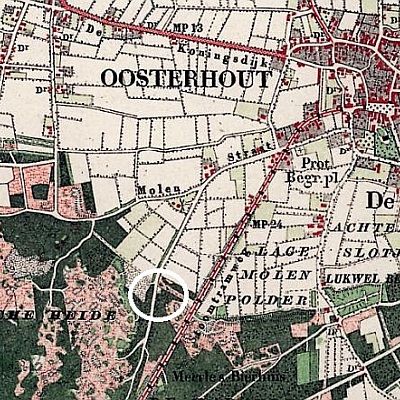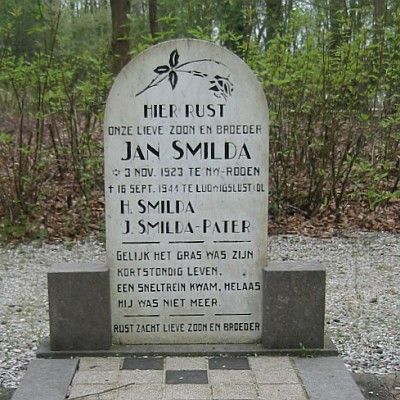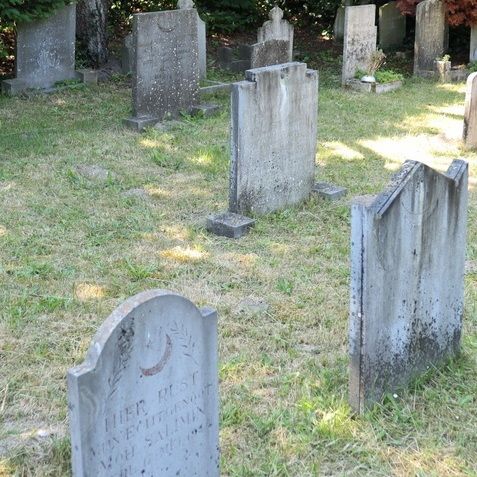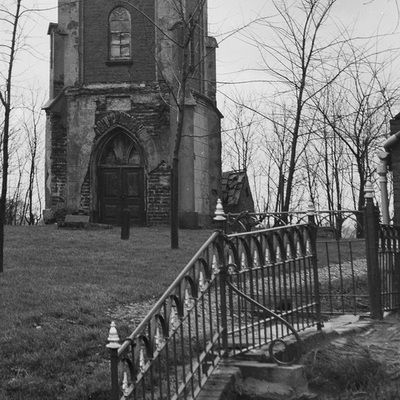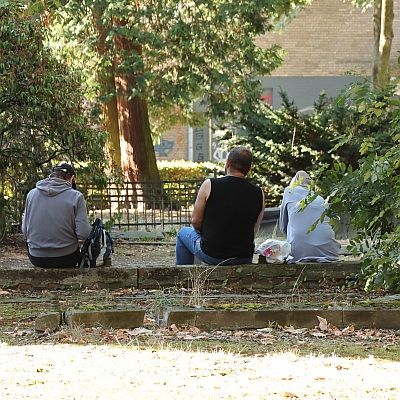De St. Franciskerk van Fort Kochi (voormalige Cochin) in Kerala wordt vaak beschouwd als de oudste nog bestaande Europese kerk in India, zo niet de vroegst gebouwde. De kerk is een populaire bezienswaardigheid en een van de meest bezochte bezienswaardigheden in Fort Kochi. Het werd oorspronkelijk gebouwd door Portugese Franciscanen voor het klooster van Santo Antonio tussen 1518 en 1522. De faam van de kerk is ongetwijfeld verbonden met de naam van de legendarische Portugese zeevaarder Vasco da Gama, de eerste Europeaan die in 1498 een zeeroute naar India vond. Op zijn derde reis naar India stierf Da Gama in 1524 in Cochin aan de vooravond van Kerstmis, amper drie maanden na zijn aankomst. Hij werd aanvankelijk begraven in de kerk, maar zijn overblijfselen werden in 1538 gerepatrieerd naar Portugal.
 St. Francis Church in 2022 (foto Laju Paul K.)
St. Francis Church in 2022 (foto Laju Paul K.)
De St. Franciskerk is een van de eerste stenen kerken gebouwd in India met een decoratieve gevel, en dit heeft speciale betekenis voor de christenen van Kerala, omdat er talloze kerken zijn gebouwd met deze kerk als model. De oude St Thomas-christenen van Kerala hadden ongeveer honderd kerken voor de komst van de Portugezen, maar de oorspronkelijke structuren zijn niet bewaard gebleven, omdat het meestal eenvoudige gebouwen betrof die waren gebouwd met vergankelijke materialen zoals riet, palmbladeren, bamboestokken en houten balken. De Portugezen hadden meer dan een dozijn kerken in het fort, allemaal verwoest door de Nederlanders, behalve twee, de Sint-Franciscuskerk en de kathedraal van Santa Cruz. De kathedraal werd omgebouwd tot pakhuis en de kerk werd een protestants religieus gebouw onder de Nederlanders (1663-1804). Na de Nederlanders transformeerden de Britten het heiligdom tot een Anglicaanse kerk (1804-1947) en werd daarna overgenomen door de Church of South India (protestant), de huidige eigenaar (vanaf 1947).
Interessant is dat Vasco da Gama niet de enige persoon was die in de kerk werd begraven. In feite zal iedereen die een bezoek brengt aan de kerk verschillende grafstenen opmerken die tegen de zijmuren zijn geplaatst. Oorspronkelijk maakten deze grafmonumenten deel uit van graven op de kerkvloer, maar aan het einde van de negentiende eeuw werden ze door de Britten verwijderd uit de vloer en tegen de zijmuren gemonteerd. Dit zijn de grafstenen van de Portugese en Nederlandse elite van Cochin.
 Tombstone of Vasco da Gama (foto Laju Paul K.)
Tombstone of Vasco da Gama (foto Laju Paul K.)
Julian James Cotton vermeldt in zijn "List of Inscriptions on Tombs of Monuments in Madras" (1905) 28 Portugese en 19 Nederlandse grafstenen. Van de Portugese grafstenen vermeld door Cotton stammen er 7 uit de zestiende eeuw, 10 zijn ongedateerd, de oudste is voor Diogo Dias (20 januari 1546) en de jongste voor Diogo Vincente (1655). De oudste Nederlandse grafsteen is voor Sara van der Dusse (26 oktober 1664), terwijl de meest recente voor Reinier van Harn is (16 maart 1789). Anno 2022 zijn er 32 Portugese en 20 Nederlandse grafstenen, wat aangeeft dat er na de inventarisatie in 1905 door Cotton meer grafstenen zijn binnengebracht. Een van die grafstenen is die van Simeon de Miranda, wiens begrafenisdatum wordt ontcijferd als 8 augustus 1524, dat is 4 maanden voor de dood van Vasco da Gama. Dit unieke grafmonument is het oudste nog bestaande Europese grafmonument in Zuid-India, zo niet het hele land. Het werd per ongeluk ontdekt door de Britten in de late negentiende eeuw, tijdens het graven van fundamenten voor het nieuwe havenkantoor in de buurt van de oude Portugese kathedraalsite.
 Portugese en Nederlandse grafstenen (foto Laju Paul K.)Tegenwoordig zijn de Portugese grafstenen voornamelijk gerangschikt tegen de noordelijke muur van de kerk, behalve de grafsteen voor Vasco da Gama die zich in de zuidoostelijke hoek bij het koor bevindt. De Nederlandse monumenten zijn tegen de zuidmuur geplaatst en zijn beter leesbaar en artistiek superieur in vormgeving aan de Portugese. Er moet nog worden vastgesteld wat er met het stoffelijk overschot van de overledenen is gebeurd. In sommige gevallen gebruikten de Nederlanders Portugese grafstenen om hun eigen grafmonumenten te maken, zoals Cotton (1905) opmerkt dat de achterkant van de plaat van Francisco Roiz Milao (overleden 1560) en Lopez Milao (overleden 1565) is gedraaid en bewerkt om het geschikt te maken voor het grafschrift van de Nederlandse commandant Adrian van Ommen (overleden 1696). Begrafenissen buiten de Portugese en Nederlandse gemeenschappen zijn niet bekend in de kerk, maar er zijn wel enkele Engelse gedenkplaten en -tabletten te zien, een gedenksteen uit de Eerste Wereldoorlog en een Nederlands gedenkteken voor een gebouwd huis. Er is niet veel informatie beschikbaar over de biografische details van de mensen die in de kerk zijn begraven, daarom zouden studies in deze richting een spannende gelegenheid zijn om de verborgen verhalen achter elk grafmonument te ontrafelen en te zien hoe ze kunnen worden verbonden aan het diverse, multiculturele verleden van Cochin.
Portugese en Nederlandse grafstenen (foto Laju Paul K.)Tegenwoordig zijn de Portugese grafstenen voornamelijk gerangschikt tegen de noordelijke muur van de kerk, behalve de grafsteen voor Vasco da Gama die zich in de zuidoostelijke hoek bij het koor bevindt. De Nederlandse monumenten zijn tegen de zuidmuur geplaatst en zijn beter leesbaar en artistiek superieur in vormgeving aan de Portugese. Er moet nog worden vastgesteld wat er met het stoffelijk overschot van de overledenen is gebeurd. In sommige gevallen gebruikten de Nederlanders Portugese grafstenen om hun eigen grafmonumenten te maken, zoals Cotton (1905) opmerkt dat de achterkant van de plaat van Francisco Roiz Milao (overleden 1560) en Lopez Milao (overleden 1565) is gedraaid en bewerkt om het geschikt te maken voor het grafschrift van de Nederlandse commandant Adrian van Ommen (overleden 1696). Begrafenissen buiten de Portugese en Nederlandse gemeenschappen zijn niet bekend in de kerk, maar er zijn wel enkele Engelse gedenkplaten en -tabletten te zien, een gedenksteen uit de Eerste Wereldoorlog en een Nederlands gedenkteken voor een gebouwd huis. Er is niet veel informatie beschikbaar over de biografische details van de mensen die in de kerk zijn begraven, daarom zouden studies in deze richting een spannende gelegenheid zijn om de verborgen verhalen achter elk grafmonument te ontrafelen en te zien hoe ze kunnen worden verbonden aan het diverse, multiculturele verleden van Cochin.
Cochin was een van de weinige steden in India die werd gecontroleerd door drie Europese mogendheden - de Portugezen, de Nederlanders en de Britten. De Sint-Franciscuskerk is voor mij niet alleen bijzonder vanwege zijn historische, religieuze en architecturale betekenis, maar ook omdat het een plek is waar je een unieke mix van het erfgoed van drie verschillende Europese gemeenschappen onder één dak vindt.
In deze rubriek vertellen mensen uit het veld over een bijzondere funeraire plek. Dr. Laju Paul K. is moleculair bioloog, maar doet daarnaast onderzoek naar het Joodse erfgoed in de Indiaase staat Kerala. Hij publiceert daarover op de website Jewish Monuments of Kerala. Daarnaast doet hij onderzoek naar de Portuguese en Nederlandse aanwezigheid in Kerala en maakt sinds 2022 deel uit van het team van medewerkers van SharedCemeteries.
Header: Tekening door Thomas Whitehouse (1859), een van de oudste afbeeldingen van de kerk.
Original English version:
St. Franciskerk of Cochin and its funerary monuments
St. Francis Church of Fort Kochi (formerly Cochin) in Kerala is often considered the oldest surviving European church in India, if not the earliest built. The church is a popular landmark and one of the most visited sites in Fort Kochi. It was originally built for the Monastery of Santo Antonio (St. Antony) between 1518 and 1522 by the Portuguese Franciscans. The fame of the church is undoubtedly linked to the name of the legendary Portuguese navigator, Vasco da Gama, the first European to find a sea route to India in 1498. On his third journey to India, Da Gama died in Cochin on the eve of Christmas in 1524, barely three months after his arrival, and was first buried in the church, but his remains were repatriated to Portugal in 1538.
St Francis is one of the first stone churches built in India with a typical façade, and this has special relevance for Kerala’s Christians, as numerous churches have been constructed keeping this church as the model. The ancient St Thomas Christians of Kerala had around hundred churches before the arrival of Portuguese, but the original structures have not survived, as they were mostly simple buildings built using perishable materials such as a thatched roof, palm leaves, bamboo poles, wooden beams etc. The Portuguese had more than a dozen churches inside the fort, all destroyed by the Dutch except two, the St Francis church and the Santa Cruz cathedral. The cathedral was converted to a warehouse and the church became a Protestant religious building under the Dutch (1663-1804). After the Dutch, the British transformed the sanctuary to an Anglican church (1804-1947), and it was taken over by the Church of South India (Protestant), the current owner (1947 onwards).
 Dutch tombstones at the southern wall of the church (photo Laju Paul K.)
Dutch tombstones at the southern wall of the church (photo Laju Paul K.)
Interestingly, Vasco da Gama was not the only person to be buried inside the church. In fact, anyone who pays a visit to the church will notice several tombstones stacked against its side-walls. Originally these funerary monuments were part of graves located in the church floor, but in the late nineteenth century they were taken of the floor and mounted against the side-walls by the British. These are the gravestones of the Portuguese and Dutch elite of Cochin. Julian James Cotton in his “List of Inscriptions on Tombs of Monuments in Madras” (1905), records 28 Portuguese and 19 Dutch tombstones. Among the Portuguese tombstones listed by Cotton, 7 are from the sixteenth century, 10 are undated, the oldest belong to Diogo Dias (20 January 1546) and the youngest is for Diogo Vincente (1655); the oldest Dutch tombstone is for Sara van der Dusse (26th October, 1664), while the most recent is for Reinier van Harn (16th March, 1789). Today, there are 32 Portuguese and 20 Dutch tombstones, indicating that more gravestones were brought in afterwards. One such tombstone is that of Simeon de Miranda, whose burial date is deciphered as 8 August, 1524, that is 4 months before Vasco da Gama’s death. This unique slab is the oldest extant European funerary monument in South India, if not the whole country. It was accidentally discovered and brought to light by the British in the late nineteenth century, while digging foundations for the new Port office near the old Portuguese cathedral site. Today, the Portuguese tombstones are arranged mostly against the northern wall of the church, except Da Gama’s which is at the south-east corner near the chancel; the Dutch monuments are stacked against the southern wall, which are more legible and artistically superior in design in comparison to the Portuguese. It is yet to be determined as to what happened to the remains of the deceased. In some cases, the Dutch used Portuguese tombstones to make their own funerary monuments, as Cotton (1905) observes that the reverse of the slab of Francisco Roiz Milao (died 1560) and Lopez Milao (died 1565) has been turned and cut to make it fit used for the epitaph of the Dutch commander Adrian van Ommen (died 1696). Burials outside the Portuguese and the Dutch communities are not known in the church, but on display are also some English memorial plaques and tablets, a First World War memorial stone, and a Dutch memorial for a house built. There is not much information available on the biographical details of the people interred in the church, therefore, studies in this direction would be an exciting opportunity to unravel the hidden stories behind each grave monument and see how they can be correlated to Cochin’s diverse, multicultural past.
Cochin was one of the only cities in India controlled by three European powers-the Portuguese, the Dutch and the British. St Francis church is special for me not only due to its historical, religious and architectural significance, but also because it is a place where you find a unique blend of the heritage of three different European communities brought under one roof.
In this section people from the field talk about a special funerary place. Dr. Laju Paul K. is a molecular biologist, but also conducts research into Jewish heritage in the Indian state of Kerala. He publishes about it on the website Jewish Monuments of Kerala. In addition, he conducts research into the Portuguese and Dutch presence in Kerala and has joined the SharedCemeteries team in 2022.
Header: Drawing by Thomas Whitehouse (1859), one of the oldest representations of the church.
